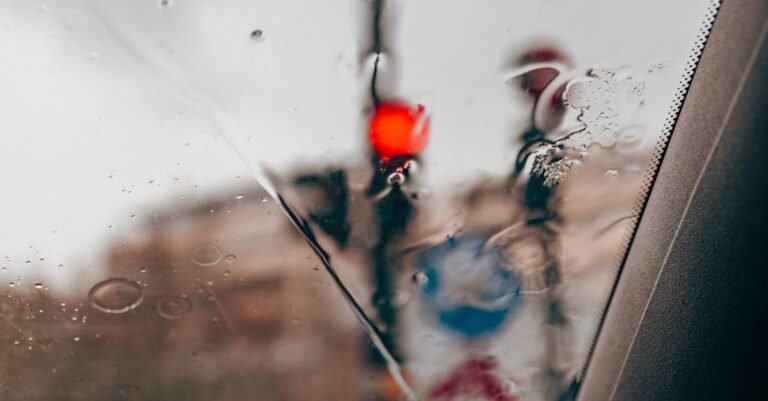Table Of Content
- Driving At Night: Essential Safety Advice for Navigating the Dark
- Why is Driving at Night More Dangerous?
- Preparing Your Vehicle for Night Drives
- Essential Pre Drive Checks for the Driver
- Safe Driving Techniques for Nighttime
- Dealing with Specific Night Driving Challenges
- Conclusion: Drive Smart, Arrive Safe
- Frequently Asked Questions (FAQs)
- FAQ 1: How often should I get my eyes checked for night driving?
- FAQ 2: Are yellow tinted night driving glasses effective?
- FAQ 3: What’s the best way to combat drowsiness while driving at night?
- FAQ 4: How can I make my car more visible to others at night?
- FAQ 5: Is it safer to avoid driving at night altogether if possible?
Driving At Night: Essential Safety Advice for Navigating the Dark
Let’s face it, driving at night is just… different. The world transforms under the cloak of darkness. Familiar roads can seem alien, distances become deceptive, and potential hazards lurk just beyond the reach of your headlights. While sometimes unavoidable, nighttime driving statistically carries a higher risk than cruising during daylight hours. But does that mean you should park your car after sunset and never leave the house? Absolutely not! It just means we need to be smarter, more prepared, and extra vigilant. Think of it like navigating a familiar room with the lights off – you know the layout, but you move more cautiously, right? This guide is here to shed some light (pun intended!) on how to navigate the roads safely after dark, offering practical tips and crucial advice to help you arrive at your destination in one piece.
Why is Driving at Night More Dangerous?
It’s not just your imagination; the statistics confirm it. Traffic fatality rates are significantly higher at night compared to the daytime. But why is that? It boils down to a combination of factors that conspire against us once the sun goes down.
Reduced Visibility: The Obvious Culprit
This one’s a no brainer. Our primary sense for driving, vision, is severely compromised in the dark. Even with the best headlights, your field of vision shrinks dramatically. You can only see as far as your beams reach, which is often much less than the distance you need to stop safely, especially at higher speeds. Color recognition fades, depth perception becomes tricky, and peripheral vision? Forget about it. Spotting pedestrians wearing dark clothing, cyclists without lights, road debris, or animals becomes a real challenge. It’s like trying to piece together a puzzle with most of the pieces missing – you only get a small fraction of the picture you’d have during the day.
Driver Fatigue: The Sneaky Saboteur
Our bodies are naturally programmed to wind down in the evening. Driving when you’re tired, especially late at night or during the wee hours when your circadian rhythm is screaming “SLEEP!”, is incredibly dangerous. Fatigue dulls your senses, slows your reaction time, impairs judgment, and can even lead to microsleeps – brief moments of sleep you might not even realize are happening. It’s a silent hazard, creeping up on you until it’s potentially too late. Think of fatigue as a dimmer switch for your brain; the more tired you are, the less processing power you have available for the complex task of driving.
Impaired Drivers: An Increased Risk After Dark
Sadly, nighttime is prime time for impaired driving. Whether it’s alcohol or drugs, the chances of encountering a driver under the influence increase significantly after dark, particularly on weekends and holidays. Impaired drivers exhibit erratic behavior – swerving, inconsistent speeds, delayed reactions – making them unpredictable and extremely dangerous hazards on the road. Sharing the road with someone whose judgment and coordination are compromised requires heightened awareness and defensive driving skills from your end.
Wildlife Encounters: Unpredictable Road Hazards
Many animals, especially deer, are most active during dusk and dawn, and throughout the night. Their eyes might reflect your headlights, but they can dart onto the road with startling speed, giving you very little time to react. This is particularly true on rural roads or highways passing through wooded areas. A collision with a large animal like a deer can cause significant vehicle damage and serious injury. They are the ultimate unpredictable element in the night driving equation.
Preparing Your Vehicle for Night Drives
Okay, so we know the risks. The good news is, we can mitigate many of them with some simple preparation. Your car is your trusty steed for navigating the night, and ensuring it’s in top shape is non negotiable.
Headlights: Your Eyes in the Dark
Your headlights are arguably the most critical safety feature for night driving. They don’t just help you see; they help others see you. Giving them some regular TLC is essential.
Checking Alignment and Brightness
Are your headlights pointing correctly? Misaligned headlights can be ineffective, illuminating the treetops or the ditch instead of the road ahead. Worse, they can blind oncoming drivers. Most vehicles have adjustment screws, but it’s often best to have a mechanic check and adjust the alignment professionally. Also, check if both headlights are working and if they seem dim. Headlight bulbs degrade over time, losing brightness before they burn out completely. Consider upgrading to brighter, whiter bulbs if appropriate for your vehicle and local regulations, but ensure they’re properly aimed!
Cleaning Lenses Regularly
This seems basic, but you’d be surprised how much difference clean headlights make. Over time, plastic headlight lenses can become yellowed, hazy, or cloudy due to UV exposure and road grime. This significantly reduces the amount of light that gets through. Regularly washing your car helps, but if they’re hazy, use a headlight restoration kit or have them professionally polished. A clear lens allows the maximum amount of light to shine through, improving your visibility dramatically. Think of it like cleaning your glasses – smudges drastically impair your vision, and the same goes for your car’s “eyes.”
Windshield and Wipers: Ensuring Clear Vision
A dirty or streaky windshield is annoying during the day, but it can be downright dangerous at night. Headlight glare from oncoming cars refracts through dirt, smudges, and streaks, creating a blinding effect. Keep your windshield spotless, inside and out. Ensure your wiper blades are in good condition – not cracked, brittle, or leaving streaks. Replace them at least once a year or sooner if needed. And always, always keep your washer fluid reservoir topped up, preferably with a fluid that has bug removing capabilities.
Mirrors: Maximizing Your Awareness
Clean and properly adjusted mirrors are crucial for knowing what’s happening around you, especially at night. Clean your side and rearview mirrors regularly. Adjust your side mirrors to minimize the blind spot – you should just barely see the side of your own car. Adjust your rearview mirror for the clearest view behind you. Many modern cars have auto dimming rearview mirrors, which are fantastic for reducing glare from headlights behind you. If you don’t have one, use the manual day/night switch on your mirror when necessary.
Essential Pre Drive Checks for the Driver
Just as important as prepping your car is prepping yourself. You are the captain of the ship, and your condition directly impacts safety.
Are You Fit to Drive? Checking for Fatigue
Be honest with yourself. Are you tired? Driving drowsy can be as dangerous as driving drunk. If you’re feeling sleepy before you even start, reconsider your trip. Can it wait until morning? If you must drive, plan ahead. Get adequate sleep the night before a long night drive. Avoid heavy meals before driving, as they can make you drowsy. If you start feeling tired while driving, don’t try to tough it out. Pull over in a safe, well lit place (like a rest stop) and take a short nap (15 20 minutes can make a difference) or switch drivers if possible. Caffeine can provide a temporary boost, but it’s not a substitute for rest.
Vision Check: Can You See Clearly?
Our vision naturally changes as we age, and conditions like cataracts or glaucoma can significantly impact night vision. If you wear glasses or contacts, ensure your prescription is up to date. Get regular eye exams, and specifically mention to your optometrist if you experience difficulties driving at night. They can check for issues and recommend appropriate solutions. Even if you have perfect daytime vision, you might still struggle more at night. Reducing dashboard light brightness can help your eyes adapt better to the darkness outside.
Safe Driving Techniques for Nighttime
Alright, car’s ready, you’re alert – now let’s talk about *how* to drive when visibility is limited and risks are higher.
Slow Down: Adjusting Your Speed
Speed limits are set for ideal, daytime conditions. At night, with reduced visibility, you simply have less time to react to unexpected hazards. Outrunning your headlights – driving so fast that you can’t stop within the distance illuminated by your lights – is a recipe for disaster. Reduce your speed, especially on unlit roads, curves, or in unfamiliar territory. Driving slower gives you more time to perceive a hazard, react, and brake safely. Think of it as giving yourself a crucial time bonus.
Increase Following Distance: Creating a Buffer Zone
Tailgating is dangerous anytime, but it’s especially foolish at night. Since judging distances and speeds is harder in the dark, you need more space between your vehicle and the one in front. Instead of the standard three second rule used during the day, aim for at least four to six seconds of following distance at night. This buffer gives you more time to react if the car ahead brakes suddenly or swerves to avoid something you can’t yet see.
Use Your High Beams Wisely
Your high beams significantly extend your visibility range on dark roads. Use them whenever possible on unlit stretches, like highways or rural roads, but only when there are no oncoming vehicles or cars close ahead of you. Be courteous and responsible: dim your lights immediately when you see oncoming headlights or the taillights of a vehicle you’re approaching. Failing to do so can temporarily blind other drivers, creating a dangerous situation for everyone. Get in the habit of constantly scanning ahead and being ready to switch between low and high beams.
Managing Headlight Glare from Oncoming Traffic
Oncoming headlights, especially modern ultra bright ones or poorly aimed ones, can be temporarily blinding. Don’t stare directly into the lights! When faced with bright oncoming headlights, avert your gaze slightly downward and to the right. Focus on the white line marking the right edge of the road or the lane marking. This helps you maintain your lane position without being dazzled. Also, as mentioned before, keeping your windshield clean and using the night setting on your rearview mirror significantly helps reduce glare.
Staying Alert and Avoiding Distractions
Night driving requires your full attention. Minimize distractions inside the car. Keep the radio volume reasonable, avoid engaging in complex or emotional conversations, and absolutely do not use your phone (handheld or hands free). Keep your eyes moving, constantly scanning the road ahead, the sides of the road, and your mirrors. Look further down the road than you normally would during the day. Chew gum, listen to upbeat music (at a moderate volume), or open a window slightly for fresh air if it helps you stay focused. If you have a passenger, ask them to help watch for hazards.
Dealing with Specific Night Driving Challenges
Night driving throws unique curveballs. Here’s how to handle some common tricky situations.
Driving in Bad Weather at Night (Rain, Fog)
Rain and fog reduce visibility dramatically, and at night, it’s even worse. Rain scatters headlight beams and makes roads slick. Fog can reduce visibility to near zero. In these conditions:
- Slow down significantly: More than you normally would for bad weather during the day.
- Use low beams: High beams reflect off rain and fog, making it harder, not easier, to see. Use fog lights if you have them, but remember to turn them off when conditions clear.
- Increase following distance drastically: Stopping distances increase significantly on wet roads.
- Be extra cautious: Road markings may be obscured.
- If visibility is severely limited (heavy fog): The safest option is often to pull over in a safe place completely off the road and wait for conditions to improve. Turn on your hazard lights if stopped near the roadway.
Navigating Rural Roads After Dark
Rural roads often lack streetlights, have sharper curves, and present a higher risk of wildlife encounters.
- Use high beams extensively: But remember to dim them for other vehicles.
- Scan the roadsides actively: Look for the reflective eyes of animals. Be especially cautious near wooded areas, water sources, and deer crossing signs.
- Be prepared for unexpected stops: Farm equipment might be moving slowly, or animals could be on the road.
- Slow down before curves: You can’t see what’s around the bend.
- Know your route or use GPS: Getting lost on dark, unfamiliar rural roads is stressful and potentially dangerous.
What to Do If You Break Down
Breaking down is stressful anytime, but at night on a dark road, it’s particularly hazardous due to low visibility.
- Pull over as far as possible: Get your vehicle completely off the traveled roadway if you can, preferably onto the right shoulder.
- Turn on hazard lights immediately: This makes your vehicle visible.
- Stay in your vehicle (usually): If you’re on a busy highway or in a precarious spot, it’s often safer to stay inside with your seatbelt on and call for help. Getting out, especially on the traffic side, is dangerous.
- If you must exit: Do so carefully from the passenger side, away from traffic. Wear light colored or reflective clothing if possible.
- Make yourself visible: If safe to do so and you have them, place reflective triangles or flares behind your vehicle to warn oncoming traffic (check local laws regarding placement). Turn on your interior dome light.
- Call for assistance: Use your mobile phone to call roadside assistance or emergency services. Be ready to give your exact location.
Conclusion: Drive Smart, Arrive Safe
Driving at night doesn’t have to be a white knuckle experience. While the risks are inherently higher due to factors like reduced visibility and fatigue, they are manageable. By understanding the challenges, preparing your vehicle properly, ensuring you’re fit to drive, and employing smart, defensive driving techniques, you can significantly improve your safety on the road after dark. It’s about respect – respecting the conditions, respecting your limitations, and respecting the potential hazards. So, clean those headlights, check your mirrors, get enough rest, slow down, stay alert, and use those high beams wisely. Drive smart, stay vigilant, and ensure every nighttime journey ends safely back home.
Frequently Asked Questions (FAQs)
FAQ 1: How often should I get my eyes checked for night driving?
It’s generally recommended to have a comprehensive eye exam every one to two years, depending on your age and risk factors. If you notice increased difficulty seeing at night, experiencing more glare than usual, or have other vision concerns, schedule an appointment sooner. Be sure to specifically mention your night driving concerns to your eye doctor.
FAQ 2: Are yellow tinted night driving glasses effective?
While often marketed to reduce glare and improve contrast, most eye care professionals advise against using yellow tinted glasses for night driving. While they might make things seem brighter or sharper subjectively, they actually reduce the overall amount of light reaching your eyes, which can be detrimental in low light conditions. Anti reflective coatings on regular prescription glasses are generally more effective at reducing glare.
FAQ 3: What’s the best way to combat drowsiness while driving at night?
The only real cure for drowsiness is sleep. However, if you find yourself getting tired while driving, the safest immediate actions are:
- Pull over in a safe, well lit area (like a rest stop or service station) and take a 15 20 minute power nap.
- Consume caffeine (coffee, tea, caffeinated soda) – it takes about 30 minutes to take effect and offers only a temporary boost.
- If possible, switch drivers with an alert passenger.
- Do not rely on rolling down the window or turning up the radio; these are ineffective long term solutions. Plan ahead to avoid driving tired in the first place.
FAQ 4: How can I make my car more visible to others at night?
Ensure all your lights are working: headlights (low and high beam), taillights, brake lights, and turn signals. Keep your lights clean. Use your headlights whenever visibility is reduced, not just after sunset but also during dawn, dusk, rain, or fog. Some drivers add reflective tape strategically to bumpers or sides (check local regulations), but ensuring your standard lights function correctly is the most crucial step.
FAQ 5: Is it safer to avoid driving at night altogether if possible?
Statistically, yes, driving during daylight hours is safer. If you have the option, especially for long trips or if you feel uncomfortable driving at night (perhaps due to vision issues or fatigue), planning your travel during the day is a sensible choice. However, for many people, night driving is unavoidable. By following the safety advice outlined above, you can significantly minimize the associated risks.









